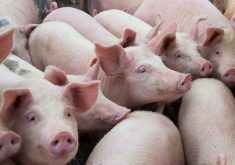DAY TWO OF GRAINWORLD
MGEX SESSION ON WHEAT FUTURES
Darin Newsom of DTN, one of my favourite analysts, is making the point that the MGEX is far more commercial-market-reflective than either Chicago or Kansas City. “Ultimately the price in Minneapolis comes back to the cash market.” Chicago, on the other hand, has a contract with many convergence problems.
On whether or not crop prices are unsustainably high: “We are not in an ag bubble.”
Interesting point just made by Joe Victor: if you combine U.S. and Canadian Hard Red Spring Wheat, it is the dominant type of wheat grown in North America, more important than soft red winter or hard red winter, which get a lot more notice.
Read Also

Invigor Gold variety viewed as threat to condiment mustard
Invigor Gold, the canola-quality mustard developed by BASF, is on a collision course with Canada’s condiment mustard industry. It’s difficult to see how the two can co-exist.
Could a contract that combines both crops become the dominant wheat futures market? That’s what I’m wondering.
WHEAT FUTURES PANEL
The CBOT, the MGEX and the ICE are all here hawking their wheat futures contracts.
Brad Vannan of ICE Futures Canada is explaining why Western Canada needs its own wheat futures contract: it’s the centre of the production area of HRSW in North America, it has a different breakdown of export versus domestic than the U.S. HRSW crop has, and Canadian farmers prefer Canadian dollar denominated futures. Also the Winnipeg contract will have prairie delivery points that will reveal real commercial prices on the prairies. Port delivery creates anomalies. “We don’t want these short term anomalies to have an impact on our contract.”
Joe Victor of MGEX: “Liquidity: I don’t think we have a problem.” Victor just noted that the MGEX had a few months in 2011 when more than one billion bushels worth of wheat were traded through the exchange. Neither Kansas City nor Chicago reflect high protein wheats. Victor is detailing the very different situation that often affects HRSW in years like this, when stocks are not big for HRSW, but big for SRW that is traded in Chicago. But he says HRSW sets durum prices.
Andriessen of CBOT owner CME Group is pointing out the overwhelming dominance of the Chicago contracts for general world wheat hedging. Superhigh liquidity. When you need to get out, you can get out. Says Chicago has the best trading platform, plus all sorts of extras like calendar spreads and OTC connections that no other wheat contracts have.
“One of the most important things you need to think about is liquidity.”
DING DONG THE (CWB) WITCH IS DEAD
That song was just played by the daughter of a longtime anti-CWB farmer who is elated by the ending of the wheat board monopoly. That shows you how different this year’s show is from past years.
RISK MANAGEMENT
There’s an excellent Q and A session going on right now with the risk management panel that’s just finished its formal presentations. Good questions from the likes of Chuck Penner of LeftField Commodity Research and Brenda Tjaden Lepp of FarmLink Marketing Solutions. So much good stuff I can’t write it out here. Will have to do a column for next week’s paper . . .
MARTIN CHIDWICK – BISSMA PACIFIC
Chidwick says deferred delivery contracts with no act of god clause are far too risky for farmers. Example: the red lentils market.
Special crops and pulses require an excellent understanding of the buyer, because there is an especial risk of “risk at destination” from buyers not paying or sticking with contracts.
KEITH BRUCH OF PATERSON
Keith Bruch of Paterson Globalfoods is discussing the pricing options grain companies will likely be offering.
Bruch said he hopes Winnipeg wheat futures work, because they are designed for the prairie crop, but liquidity is always the question. There have been huge basis swings between the three wheat futures contracts in the past three years, and this can be dangerous. Which contract can you use safely to hedge a prairie crop? The MGEX contract reveals the extreme swings in the protein premium. In the past year, the premium of the Minneapolis contract versus the Chicago contract has ranged from five dollars per bushel to one dollar per bushel. “This is huge.”
Bruch said farmers need to base everything on cash flow analysis, and this will become more important in the future.
Until ICE durum contracts become liquid, pooling might make sense for farmers who want to avoid the extreme volatility of the durum market.
GORD FLATEN OF CWB
Flaten is explaining why farmers might want to use pooling in an open market environment.
Pooling is a “disciplined approach” of price averaging that gets away from the perennial problem of market timing. “It is really hard to time the market.”
Pooling also creates a lot of flexibility for signing-up and for moving off-grades of wheat. A big pooling structure can find markets for grains that aren’t quite what the producer expected.
FOCUS ON RISK MANAGEMENT TOOLS
John DePape introduced a panel looking at risk management in crops by noting what Bill Wilson of NDSU noted yesterday: there are lots of risk management tools and methods, but lots of people don’t know anything about them.
This morning the first panel looks at new CWB pooling, at grain company hedging, and at special crops hedging. The second panel will look at wheat futures at Winnipeg’s ICE exchange, the MGEX of Minneapolis, and Chicago’s CME Group.
**********************************
Day One
Throughout the day I’ll be chucking up summaries of some of the points the speakers are making at Grainworld, the ag outlook conference that Wild Oats has taken over from the Canadian Wheat Board.
It’s going to be interesting if anyone here today sheds some light and detail on the evolution of the post-monopoly system, because there is still an ocean of unknownness out there that we’re all adrift upon.
BILL WILSON – NORTH DAKOTA STATE UNIVERSITY
Bill Wilson, an incredible resource for people who care about wheat futures markets, is speaking right now about how the North American wheat market is likely to develop in the post-monopoly era.
Wilson says lots of changes are occurring with existing contracts, affecting both source and qualities like vomitoxin levels.
Problem for wheat futures: basis risk has become huge compared to the pre-2005 period. Especially with high protein wheat, the basis has become incredibly volatile.
“Which market should I hedge in?” Prime question for producers considering using futures hedges. With wheat, there will be four contracts.
Quality risk is a huge risk for the farmer because the grain buyers won’t accept deviations from specs, dumping all the risk on him.
NO HOG OR CATTLE OUTLOOK THIS YEAR
There are no livestock outlooks at GrainWorld this year. This surprised me, because I expect a couple of half-hearted livestock outlooks to occur here, because they do every year. Like the snow in the winter, and mosquitoes in the summer, they have been comfortable but not cheery assumptions you can bank on. But organizer John Duvenaud, in the program, explains: “My plan was to keep Grainworld operating at the CWB had run it, but when I looked more closely at getting farmers to drive to Winnipeg for an ag outlook, realized that livestock is a different industry. Thus a total concentration on the crops we grow on the prairies.”
Amen to that one, I say. I never thought it made sense to chuck in a couple of livestock outlooks at a day-and-a-half crop outlook conference.
CANOLA ACREAGE ACCORDING TO LOUIS DREYFUS
Lussier of Louis Dreyfus said the company believes prairie canola acreage will be more than 21 million acres this spring. That’s a bunch, to use a technical term. The reason for the hugeness of canola acreage in 2012 is the wheat-canola spread, which this year is favouring canola much more than it did last year.
“We truly do require 21 million tonnes to meet demand.”
A very, very bullish forecast for both old crop and new crop.
GRANT DEVINE – FARMLAND AS A STRATEGIC ASSET
Since I had to write stories for the actual paper version of the newspaper, I couldn’t be there to hear what the former Saskatchewan premier said. But as a crafty reporter, I didn’t need to, because I left my backup voice recorder right in front of the podium, so in a couple of days’ time I’ll be able to hear the speech better than if I was sitting at a cruddy hotel table swilling bad coffee. That’s thinking, eh?
FRASER GILBERT – SGS
Ex-longtime CGC grain grader and private grain grader Fraser Gilbert echoed a sentiment I’ve heard here all morning: the world wants lower-quality wheat than we’ve been giving it, and we need to be able to produce more wheat of lower qualities if we want to be able to make wheat a better-paying commodity. Instead of smirking at the Former Soviet Union states and their low quality wheats, we should be emulating them, but with better production methods and better management.
Gilbert says Canada is often providing wheat with far higher quality than the specs in contracts.
TOM DESMET – CENEX HARVEST STATES
The New Durum World: durum will be volatile, and the CWB used to handle the risk. That’s now in farmers and grain companies’ hands. Farmers need to understand a tiny market and production zone like durum’s can have more severe problems and be more volatile than for bigger acreage crops.
Durum is “extremely dangerous” in terms of price risk from not hitting the specs the buyers want. The CWB looked after that, but in the open market, farmers need to understand how wild the price can drop if specs aren’t met. If you contract a $9 per bushel durum, don’t hit spec and the market rises in the meantime, you can end up with $3 per bushel for your crop.
“Durum is the riskiest commodity.”
LAWRENCE YAKIELASHEK – TOEPFER
Lawrence Yakielashek of Toepfer says the new wheat marketing environment will shake things up.
“There are going to be some dramatic winners and some dramatic losers.”
Canada is behind in grain marketing, he said. There is an opportunity to catch up.
Why have competitors caught up and surpassed us? Developing nations like the Former Soviet Union have “access to fertilizer, seed, handling . . . “
Also, Canada has had a skewed obsession with “high quality” wheat, which the world doesn’t pay for. “We’re getting our butts kicked” because the world’s buyers don’t care about quality.
BILL LAPP OF ADVANCED ECONOMIC SOLUTIONS
A libertarian by nature, Lapp sees little success from the many U.S. government attempts to manipulate agricultural economics.
“To overcome those economic realities is a virtual impossibility.”
MURDOCH MACKAY OF THE CANADIAN GRAIN COMMISSION
The grain grading system is “very flexible” and can handle a lot of customized specs based off main grading, CGC commissioner Murdoch MacKay just said. Protein is not part of grading. Much demand for mid-grade wheats can come from varieties already existing.
Variety registration: not a specific system overseen by the CGC. Stakeholders would have to change them if they want.
Many changes since 1912: more efficient system, fewer elevators, more information, vertical integration. Now the ending of the CWB’s monopolies adds a further fundamental change to the system.
Since 2006 many discussions and consultations about how to change and improve the Canada Grain Act. “The only problem is that nobody can agree.” Most players have been focused on their particular needs.
Much support for modernizing the Canada Grain Act, especially in the new environment of a post-monopoly world. The present commissioners think the CGC eeds to: clarify the CGC’s mandate, probably to work in the interests of the country as a whole, rather than producers only; move towards having a president and CEO rather than three commissioners; develop a non-binding alternative dispute resolution system; modernize licensing to fit new grain handling methods; financial security for farmers maintained, but reformed; eliminate unnecessary inland weighing and inspection at transfer elevators and stations, as well as for lakers;
If the inland inspection is abandoned, the Grain Appeal Tribunal could be eliminated.
CGC should still inspect outward bound grain, but do it through third party providers rather than CGC staff.
“I know there are people who think we should not be involved in outward inspection,” said MacKay, but with all the changes and challenges, there’s still a role for the CGC there.
ACREAGE OUTLOOK BY FARMLINK
Jon Driedger of FarmLink Marketing Solutions says there will be more acres of canola than wheat this spring, Barley should smartly increase, which makes sense, because “this really is one of the best returning crops in the rotation.”
Durum and oats will increase a bit, but not a bunch.
Canola will swallow up special crops acreage.
Lentil acres will grow this year to above the five year average, which could be bad because of world supplies.
On the CWB changes’ influence on acreage decisions: “We don’t think there’s going to be a big change in the mix because of that.”
GERRY RITZ’ REMARKS
Federal Ag Minister Gerry Ritz noted that the Manitoba Court of Queen’s Bench “flatly denied” the injunction request to stop implementation of the new CWB act. “It’s a great victory.”
“It’s the beginning of a new era.”
Other topics: CWB will still be in business and has government support “for up to five years”; Chinese trade is booming with two-way investment; U.S. trade is a continuing strength for the industry; the federal government supports Churchill; institutions like the Canadian Grain Commission are important;
In response to a question, Ritz said the wheat and barley checkoffs will not be made mandatory.
Ritz told reporters that he is not worried that commercial grain handling agreements have not yet been made between the CWB and grain companies. “There will be agreements,” he said just now.
JOHN DUVENAUD ON THE CONTINUING NEED FOR GRAINWORLD
“It’s a good thing to have accurate information.”
That’s how John Duvenaud summed up the original purpose for USDA outlook conferences, which led then into Canada’s version. And it’s why he picked up the conf when the CWB said it couldn’t do it this year.















